Effect of Plastic Fine Content on the Static Liquefaction Potential of Sandy Soil
Abstract
:1. Introduction
2. Material and Experimental Method
2.1. Materials
2.2. Experiment Devices
2.3. Testing Procedure
2.3.1. Sample Reconstitution
2.3.2. Saturation
2.3.3. Consolidation
2.3.4. Loading
2.4. Testing Program
3. Results and Discussions
3.1. Clean Sand Behavior
3.2. Effect of Fine Content on Static Liquefaction Responses for Mixtures with Very Loose State
3.3. Effect of Initial Density Index (Idi)
3.4. Effect of Confining Pressure
3.5. Effect of over Consolidation Ratio (OCR)
3.6. Liquefaction Susceptibility
4. Conclusions
- Clean sand at a very loose state (Idi = −0.2) exhibits a total collapse behavior even if for a high cell pressure (Pc = 400 kPa).
- Clean sand at a loose state (Idei = 0.1) is liquefied for three confining pressures: Pc = 50 kPa (total collapse for this case), 100 kPa, and 500 kPa.
- Clean sand samples prepared at a dense state (Idi = 0.4) are not liquefied at low confining pressure (Pc = 50 and 100 kPa) but present a limited liquefaction at high confining pressure Pc = 400 kPa.
- Specimens with fine content of up to 25%, reconstituted at a loose state (Idi = 0.0 for 0, 5, 10, and 15% of fine content; and Idi = 0.2 for 15, 20, and 25% of fine content) are liquefied (for a confining pressure Pc = 100 kPa).
- The fine content seems to present a threshold of ~10–15%. Below this value, the liquefaction resistance increases with an increase in fine content. Beyond this value, an increase in fine content leads to a decrease in the unsaturated strength. This trend is different from test results reported in the literature. It emphasizes that the effect of fine content on different sands may be different.
- The specimens with 15% fine content reconstituted at different initial density indexes from the loose state (Idi = 0.0) to the dense state (Idi = 0.6) are liquefied (for Pc = 100kPa). This trend is quite different to that of the clean sand, where the samples are liquefied at a very loose or loose state but present a dilatant response at a dense state (Idi = 0.4).
- The mixtures with 15% fine content and reconstituted at a dense state (Idi = 0.4) are liquefied (but not totally collapsed) for a range of confining pressure from 50 kPa to 400 kPa. The clean sand with Idi = 0.4 presents a limited liquefaction response under the confining pressure of 400 kPa.
- An increase in OCR until a threshold leads to an increase in the liquefaction resistance. Clean sand and mixtures are liquefied at a normally consolidated state while presenting a limited liquefaction response at over the consolidated state (for samples with Idi = 0.2 and Pc = 100 kPa).
- All the liquefied samples (both total collapse and limited liquefaction) reach the peak of deviatoric stress at an axial strain lower than 1%.
- The Chinese criterion of liquefaction susceptibility is not totally suitable for Fontainebleau’s clean sand and its mixture with Illite Arvel plastic fines.
Author Contributions
Funding
Institutional Review Board Statement
Informed Consent Statement
Data Availability Statement
Acknowledgments
Conflicts of Interest
References
- Ishihara, K.; Kawase, Y.; Nakajima, M. Liquefaction characteristics of sand deposits at an oil tank site during the 1978 Miyagiken-Oki earthquake. Soils Found. 1980, 20, 97–111. [Google Scholar] [CrossRef]
- Shengcong, F.; Tatsuoka, F. Soil Liquefaction During Haicheng and Tangshan Earthquake in China; A Review. Soils Found. 1984, 24, 22–29. [Google Scholar] [CrossRef]
- Kishida, H. Characteristics of liquefied sands during Mino-Owari, Tohnankai, and Fukui earthquakes. Soils Found. 1969, 9, 75–92. [Google Scholar] [CrossRef]
- Tohno, I.; Yasuda, S. Liquefaction of the ground during the 1978 Miyagiken-Oki earthquake. Soils Found. 1984, 21, 18–34. [Google Scholar] [CrossRef]
- Belkhatir, M.; Arab, A.; Della, N.; Schanz, T. Experimental Study of Undrained Shear Strength of Silty Sand: Effect of Fines and Gradation. Geotech. Geol. Eng. 2012, 30, 1103–1118. [Google Scholar] [CrossRef]
- Tokimatsu, K.; Yoshimi, Y. Empirical Correlation of Soil Liquefaction Based on SPT N-Value and Fines Content. Soils Found. 1983, 23, 56–74. [Google Scholar] [CrossRef]
- Cubrinovski, M.; Green, R.A.; Allen, J.; Ashford, S.; Bowman, E.; Bradley, B.; Cox, B.; Hutchinson, T.; Kavazanjian, E.; Orense, E.; et al. Geotechnical reconnaissance of the 2010 Darfield (Canterbury) earthquake. Bull. N. Z. Soc. Earthq. Eng. 2010, 43, 243–320. [Google Scholar] [CrossRef]
- Okashi, Y. Effects of Sand Compaction On Liquefaction During Tokachioki Earthquake. Soils Found. 1970, 10, 112–128. [Google Scholar]
- Seed, H.B.; Tokimatsu, K.; Harder, L.F.; Chung, R.M. The influence of SPT procedures in soil liquefaction resistance evaluations. J. Geotech. Eng. 1985, 111, 1425–1445. [Google Scholar] [CrossRef]
- Dezfulian, H. Liquefaction potential of silty sand site. Int. J. Rock. Mech. Min. Sci. Geomech. Abstr. 1986, 23, 90. [Google Scholar] [CrossRef]
- Kuerbis, R.; Negussey, D.; Vaid, Y.P. Effect of gradation and fines content on the undrained response of sand. In Proceedings of the Hydraulic Fill Structure, Geotechnic, Fort Collins, CO, USA, 15–18 August 1988; ASCE: Reston, VA, USA, 1988; pp. 330–345. [Google Scholar]
- Pitman, T.; Robertson, P.; Sego, D. Influence of fines on the collapse of loose sands. Can. Geotech. J. 1994, 31, 728–739. [Google Scholar] [CrossRef]
- Amini, F.; Qi, G. Liquefaction testing of stratified silty sands. J. Geotech. Geoenviron. Eng. 2000, 126, 208–217. [Google Scholar] [CrossRef]
- Ni, Q.; Tan, T.S.; Dasari, G.R.; Hight, D.W. Contribution of fines to the compressive strength of mixed soils. Geotechnique 2004, 54, 561–569. [Google Scholar] [CrossRef]
- Benahmed, N.; Nguyen, T.K.; Hicher, P.Y.; Nicolas, M. An experimental investigation into the effects of low plastic fines content on the behaviour of sand/silt mixtures. Eur. J. Environ. Civ. Eng. 2015, 19, 109–128. [Google Scholar] [CrossRef]
- Phan, T.A.P.V.; Hsiao, D.H.; Nguyen, T.L.P. Effects of Fines Contents on Engineering Properties of Sand-Fines Mixtures. Procedia Eng. 2016, 142, 213–220. [Google Scholar] [CrossRef]
- Jradi, L. Study of the Influence of Fine Particles on the Properties of Liquefaction of Sands. Ph.D. Thesis, University Paris-Est, Créteil, France, 2018. [Google Scholar]
- Gobbi, S.; Reiffsteck, P.; Lenti, L.; Santisi d’Avil, M.P.; Semblat, J.F. Liquefaction triggering in silty sands: Effects of non-plastic fines and mixture-packing conditions. Acta Geotech. 2022, 17, 391–410. [Google Scholar] [CrossRef]
- Polito, C. The Effects of Non-Plastic and Plastic Fines on the Liquefaction of Sandy Soils; Verginia Polytechnic Institute: Blacksburg, VA, USA, 1999. [Google Scholar]
- Naeini, S.A. The Influence of Silt Presence and Sample Preparation on Liquefaction Potential of Silty Sands. Ph.D. Thesis, Iran University of Science and Technology, Tehran, Iran, 2001. [Google Scholar]
- Bouferra, R.; Shahrour, I. Influence of fines on the resistance to liquefaction of a clayey sand. Ground Improv. 2004, 8, 1–5. [Google Scholar] [CrossRef]
- Ghahremani, M.; Ghalandarzadeh, A. Effect of plastic fines on cyclic resistance of sands. Soil. Rock. Behav. Model. 2006, 406–412. [Google Scholar]
- Murthy, T.G.; Loukidis, D.; Carraro, J.A.H.; Prezzi, M.; Salgado, R. Undrained monotonic response of clean and silty sands. Geotechnique 2008, 58, 536–538. [Google Scholar] [CrossRef]
- Stamatopoulos, C.A. An experimental study of the liquefaction strength of silty sands in terms of the state parameter. Soil Dyn. Earthq. Eng. 2010, 30, 662–678. [Google Scholar] [CrossRef]
- Belkhatir, M.; Arab, A.; Della, N.; Missoum, H.; Schanz, T. Liquefaction resistance of chlef river silty sand: Effect of low plastic fines and other parameters. Acta Polytech. Hung. 2010, 7, 119–137. [Google Scholar]
- Zhu, Z.H.; Zhang, F.; Dupla, J.C.; Canou, J.; Foerster, E. Investigation on the undrained shear strength of loose sand with added materials at various mean diameter ratios. Soil Dyn. Earthq. Eng. 2020, 137, 106276. [Google Scholar] [CrossRef]
- Koester, J.P. Influence of fines type and content on cyclic strength. In Ground Failures under Seismic Conditions; ASCE: Reston, VA, USA, 1994; pp. 17–33. [Google Scholar]
- Lade, P.; Yamamuro, J. Effects of nonplastic fines on static liquefaction of sands. Can. Geotech. J. 1997, 34, 918–928. [Google Scholar] [CrossRef]
- Thevanayagam, S.; Shenthan, T.; Mohan, S.; Liang, J. Undrained fragility of clean sands, silty sands, and sandy silts. J. Geotech. Geoenviron. Eng. 2002, 128, 849–859. [Google Scholar] [CrossRef]
- Xenaki, V.C.; Athanasopoulos, G.A. Liquefaction resistance of sand-silt mixtures: An experimental investigation of the effect of fines. Soil Dyn. Earthq. Eng. 2003, 23, 1–12. [Google Scholar] [CrossRef]
- Naeini, S.A.; Baziar, M.H. Effect of fines content on steady state strength of mixed and layered samples of a sand. Soil. Dyn. Earthq. Eng. 2004, 24, 181–187. [Google Scholar] [CrossRef]
- Yang, S.L.; Sandven, R.; Grande, L. Instability of sand-silt mixtures. Soil Dyn. Earthq. Eng. 2006, 26, 183–190. [Google Scholar] [CrossRef]
- Abedi, M.; Yasrobi, S.S. Effects of plastic fines on the instability of sand. Soil Dyn. Earthq. Eng. 2010, 30, 61–67. [Google Scholar] [CrossRef]
- Papadopoulou, A.I.; Tika, T.M. The effect of fines plasticity on monotonic undrained shear strength and liquefaction resistance of sands. Soil Dyn. Earthq. Eng. 2016, 88, 191–206. [Google Scholar] [CrossRef]
- Yang, J.; Wei, L.M. Collapse of loose sand with the addition of fines: The role of particle shape. Geotechnique 2012, 62, 1111–1125. [Google Scholar] [CrossRef]
- Monkul, M.M.; Etminan, E.; Senol, A. Coupled influence of content, gradation and shape characteristics of silts on static liquefaction of loose silty sands. Soil Dyn. Earthq. Eng. 2017, 101, 12–26. [Google Scholar] [CrossRef]
- NF P94-051; Sols: Reconnaissance et Essais—Détermination des Limites D’atterberg—Limite de Liquidité à la Coupelle—Limite de Plasticité au Rouleau. Afnor EDITIONS: Paris, France, 1993; p. 15.
- Wood, D.M. The use of the cone penetrometer to determine the plastic limit of soils. Ground Eng. 1978, 11, 3. [Google Scholar]
- Belviso, R.; Ciampoli, S.; Cotecchia, V.; Federico, A. Use of the cone penetrometer to determine consistency limits. Ground Eng. 1985, 18, 21–22. [Google Scholar]
- Kodikara, J.S. Evaluation of plastic limit and plasticity index by cone penetrometer. In Proceedings of the Asian Regional Symposium Geotechnical Problems and Practices in Foundation Engineering, Colombo, Sri Lanka, 25–27 February 1986; pp. 229–233. [Google Scholar]
- NF P94-059; Sols: Reconnaissance et Essais—Détermination des Masses Volumiques Minimale et Maximale des Sols non Cohérents. Afnor EDITIONS: Paris, France, 2000; p. 21.
- Karim, M.E.; Alam, M.J. Effect of non-plastic silt content on the liquefaction behavior of sand-silt mixture. Soil Dyn. Earthq. Eng. 2014, 65, 142–150. [Google Scholar] [CrossRef]
- Lade, P.V.; Liggio, C.D.; Yamamuro, J.A. Effects of non-plastic fines on minimum and maximum void ratios of sand. Geotech. Test. J. 1998, 21, 336–347. [Google Scholar] [CrossRef]
- Westman, A.E.; Hugill, H. The packing of particles. J. Am. Ceram. Soc. 1930, 13, 767–779. [Google Scholar] [CrossRef]
- Dang, Q.H. Comportement des Sols Sous Liquéfaction Artificielle, Amélioration des Sols à Risques Liquefiable. Ph.D. Thesis, Université Gustave Eiffel, Champs-sur-Marne, France, 2019; p. 238. [Google Scholar]
- Gobbi, S. Characterization of Liquefaction Parameters for Saturated Soil under Dynamic Loading Using Laboratory Tests and Calibration of Constitutive Laws by Numerical Modelling. Ph.D. Thesis, Université Gustave Eiffel, Champs-sur-Marne, France, 2020; p. 246. [Google Scholar]
- Ladd, R. Preparing test specimens using undercompaction. Geotech. Test. J. 1978, 1, 16–23. [Google Scholar] [CrossRef]
- Mullilis, J.P.; Townsend, F.C.; Horz, R.C. Triaxial testing techniques and sand liquefaction. In Dynamic Geotechnical Testing; ASTM International: West Conshohocken, PA, USA, 1978; pp. 265–279. [Google Scholar]
- Canou, J. Contribution a l’étude et a l’evaluation des Proprietes de Liquefaction d’un sable. Ph.D. Thesis, Ecole Nationale des Ponts et Chaussées, Paris, France, 1989. [Google Scholar]
- Ishihara, K. Liquefaction and flow failure during earthquakes. Géotechnique 1993, 43, 349–415. [Google Scholar] [CrossRef]
- Verdugo, R.; Ishihara, K. The steady state of sandy soils. Soils Found. 1996, 36, 81–91. [Google Scholar] [CrossRef]
- Benahmed, N. Comportment Mécanique d’un Sable Sous Cisaillement Monotone et Cyclique: Application au Phénomènes de Liquéfaction et Mobilité Cyclique. Ph.D. Thesis, Ëcole Nationale des Ponts et Chaussées, Champs-sur-Marne, France, 2001. [Google Scholar]
- Nguyen, K.T. Etude Expérimentale du Comportement Instable d’un Sable Silteux, Application aux Digues de Protection. Ph.D. Thesis, Université d’Aix-Marseille, Marseille, France, 2014. [Google Scholar]
- Castro, G. Liquefaction of Sands. Ph.D. Thesis, Harvard University, Cambridge, MA, USA, 1969. [Google Scholar]
- Wang, W. Some Findings in Soil Liquefaction; Water Conservancy and Hydroelectric Power Scientific Research Institute: Beijing, China, 1979. [Google Scholar]
- Seed, H.B.; Idriss, I.M. Ground Motions and Soil Liquefaction during Earthquakes; EERI Monograph: Berkeley, CA, USA, 1982. [Google Scholar]
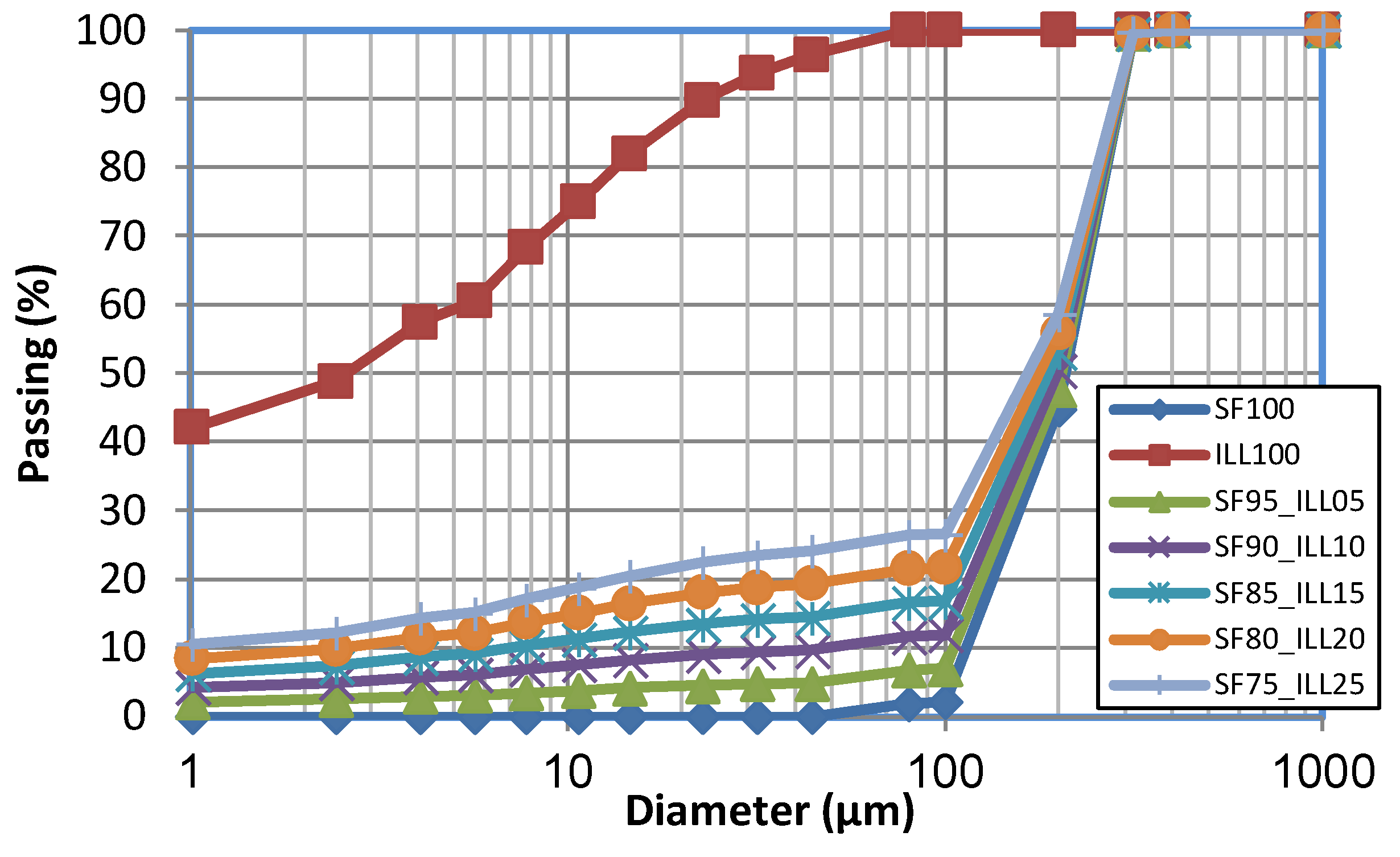
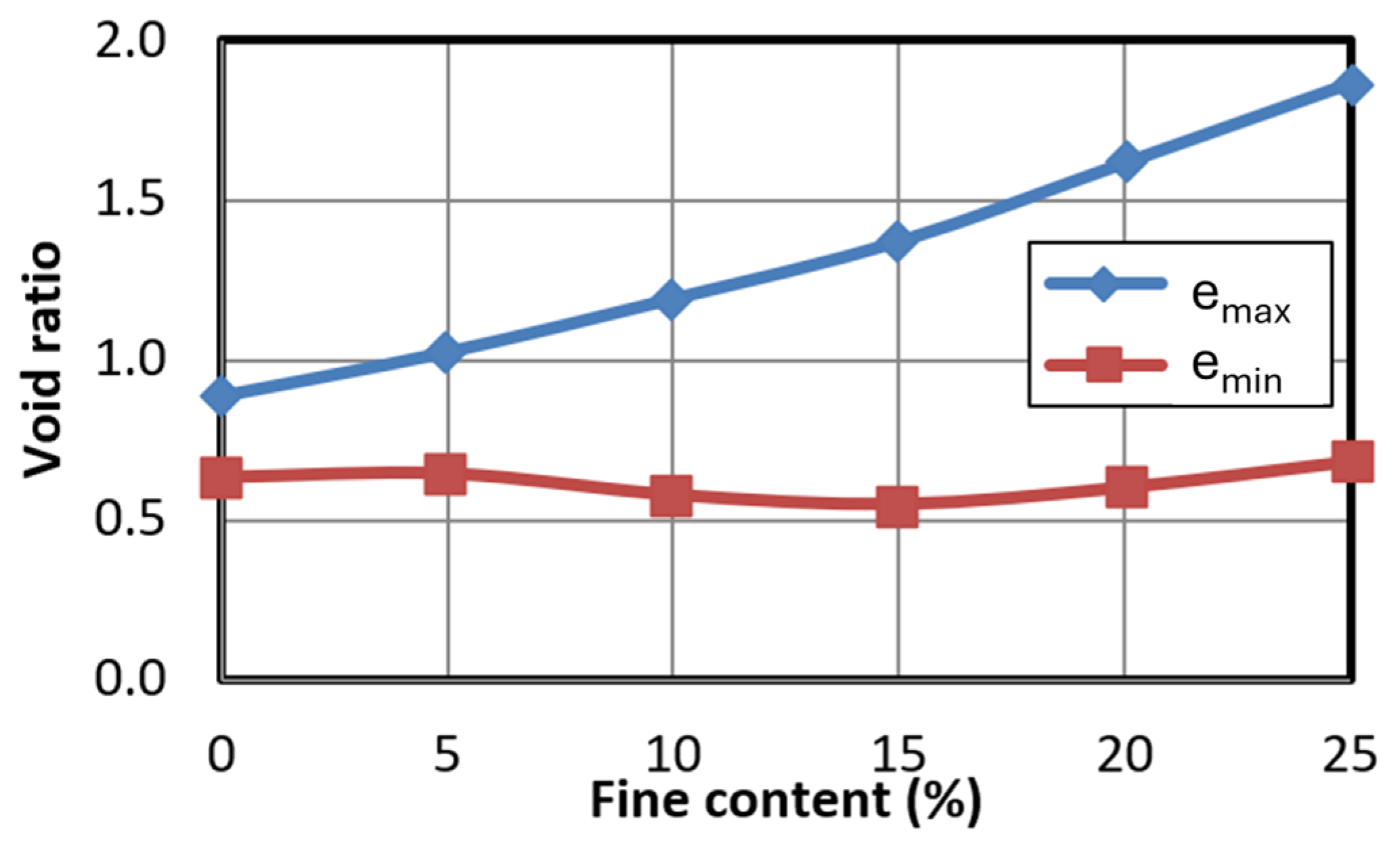
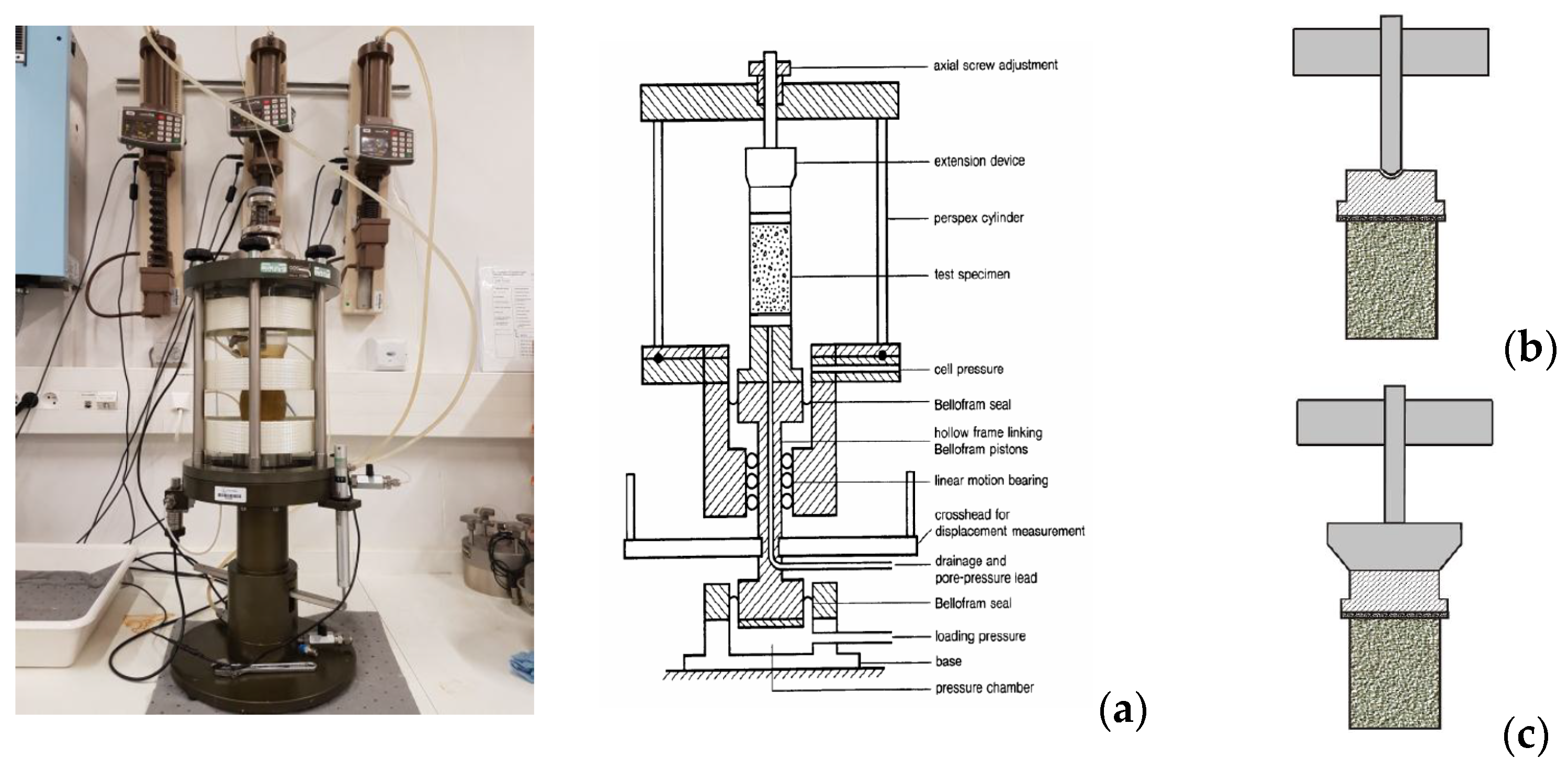
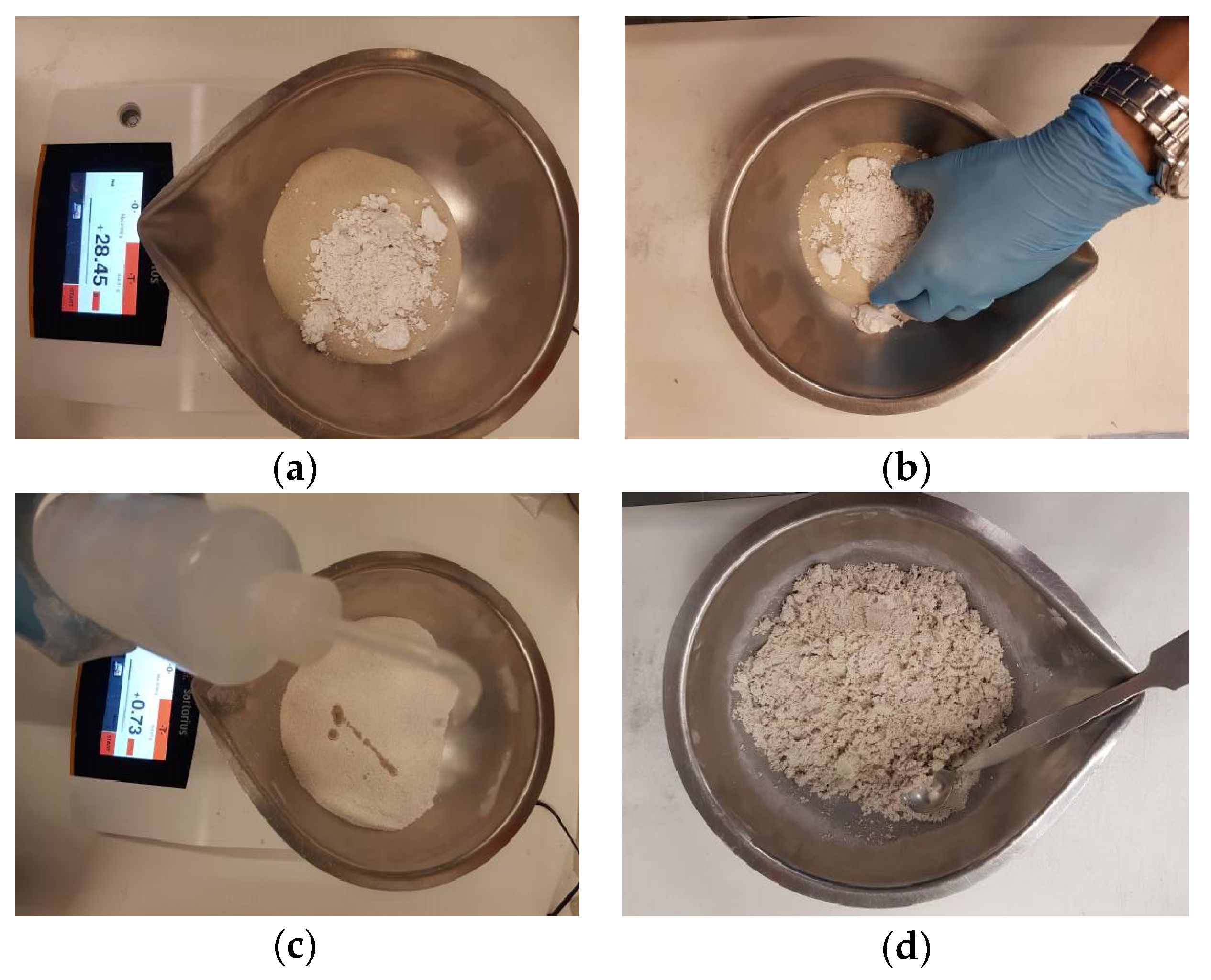
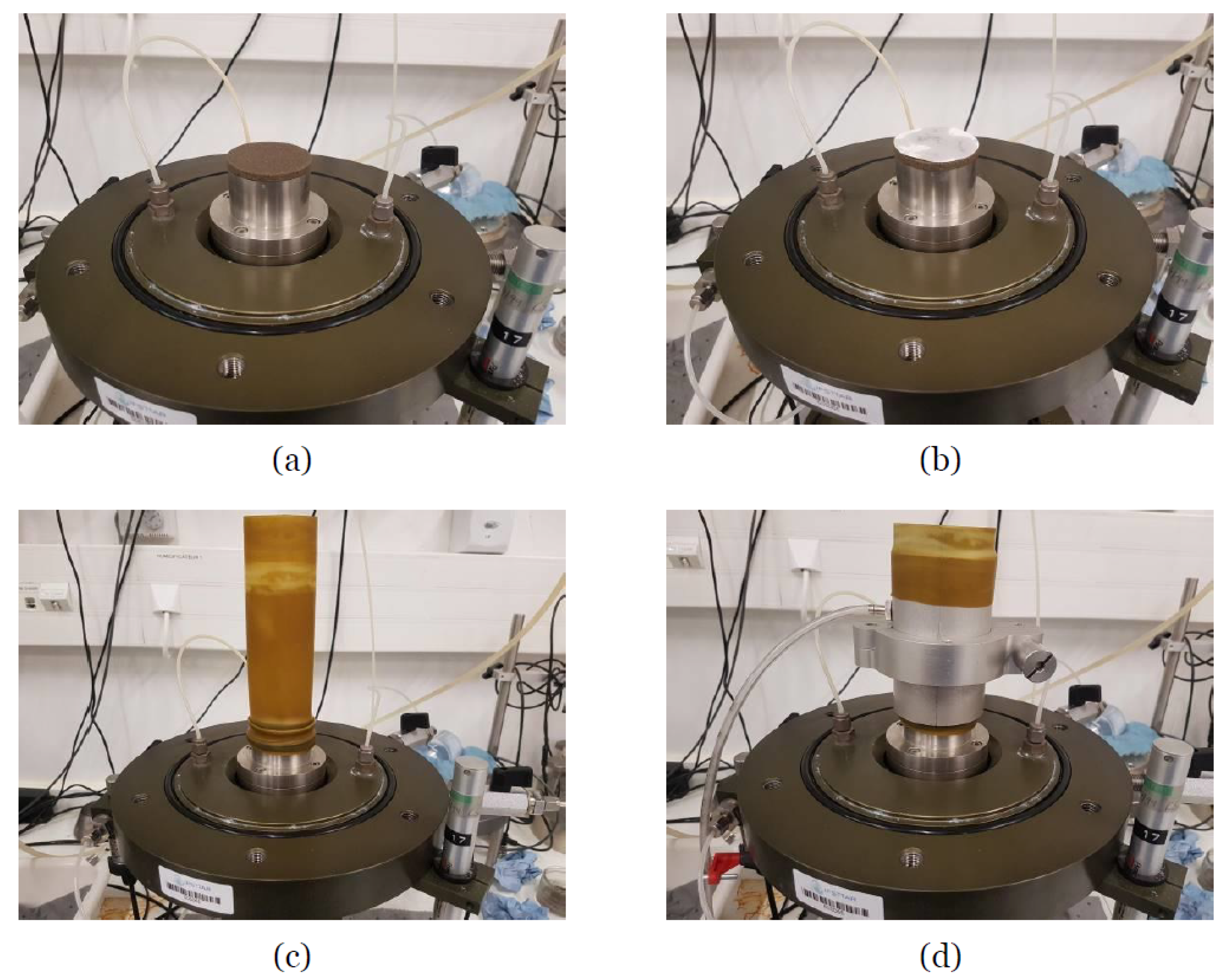
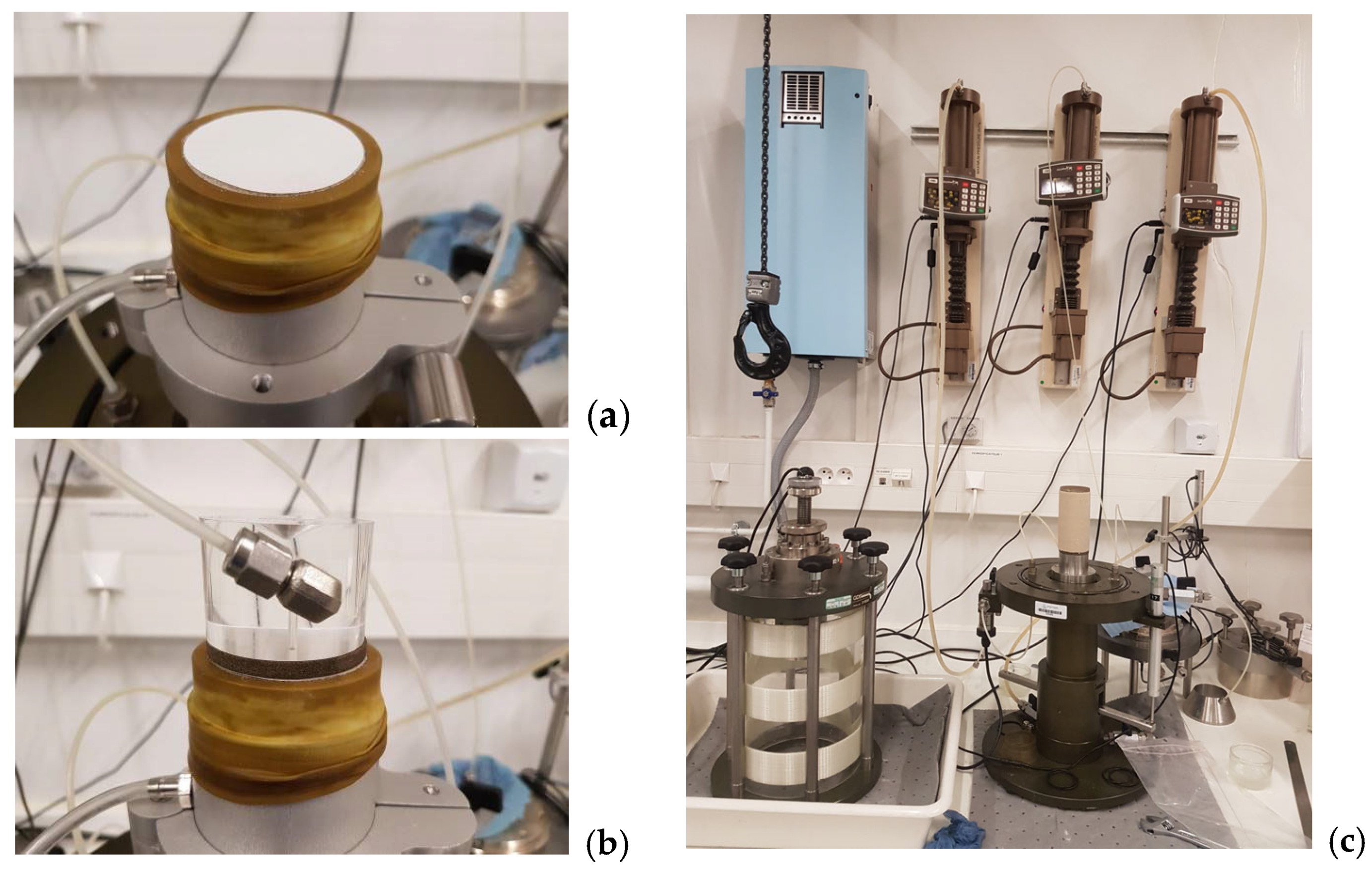

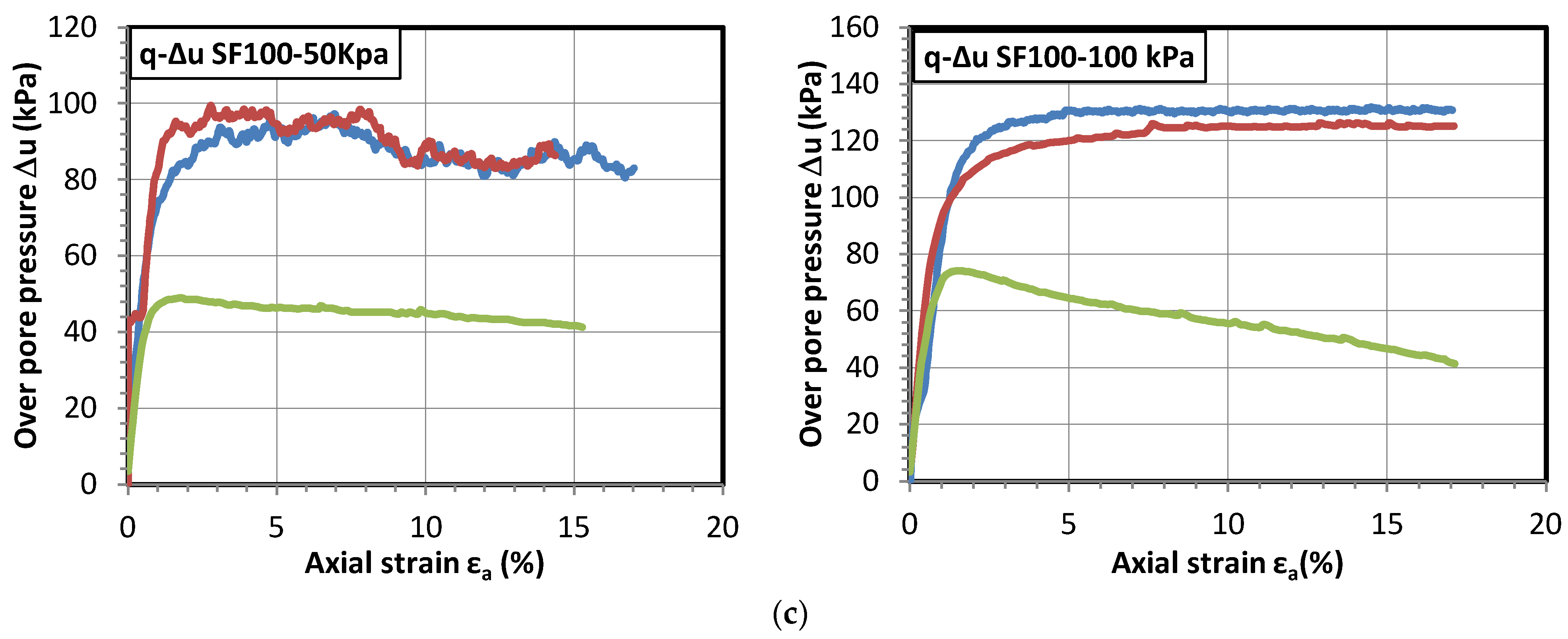
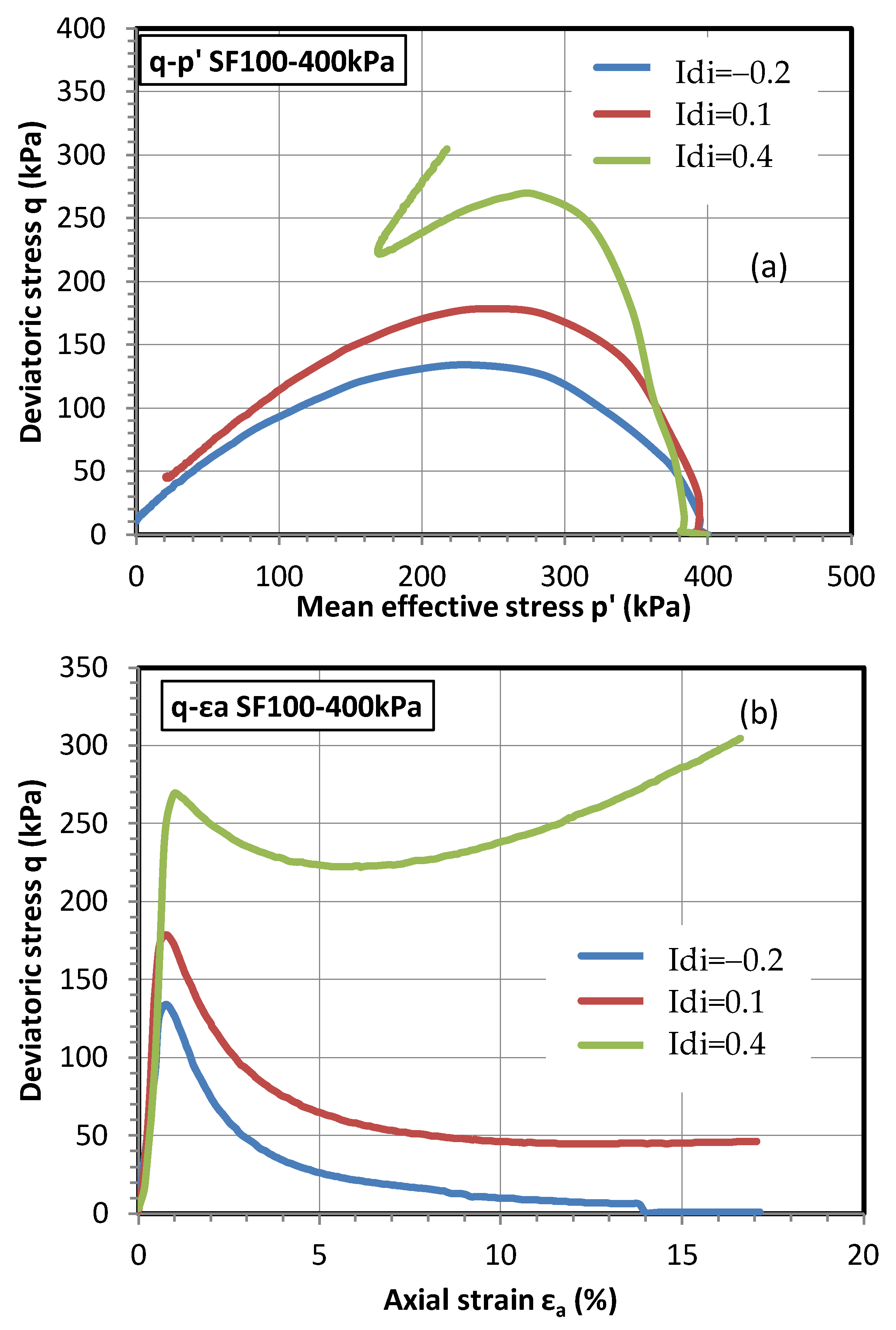
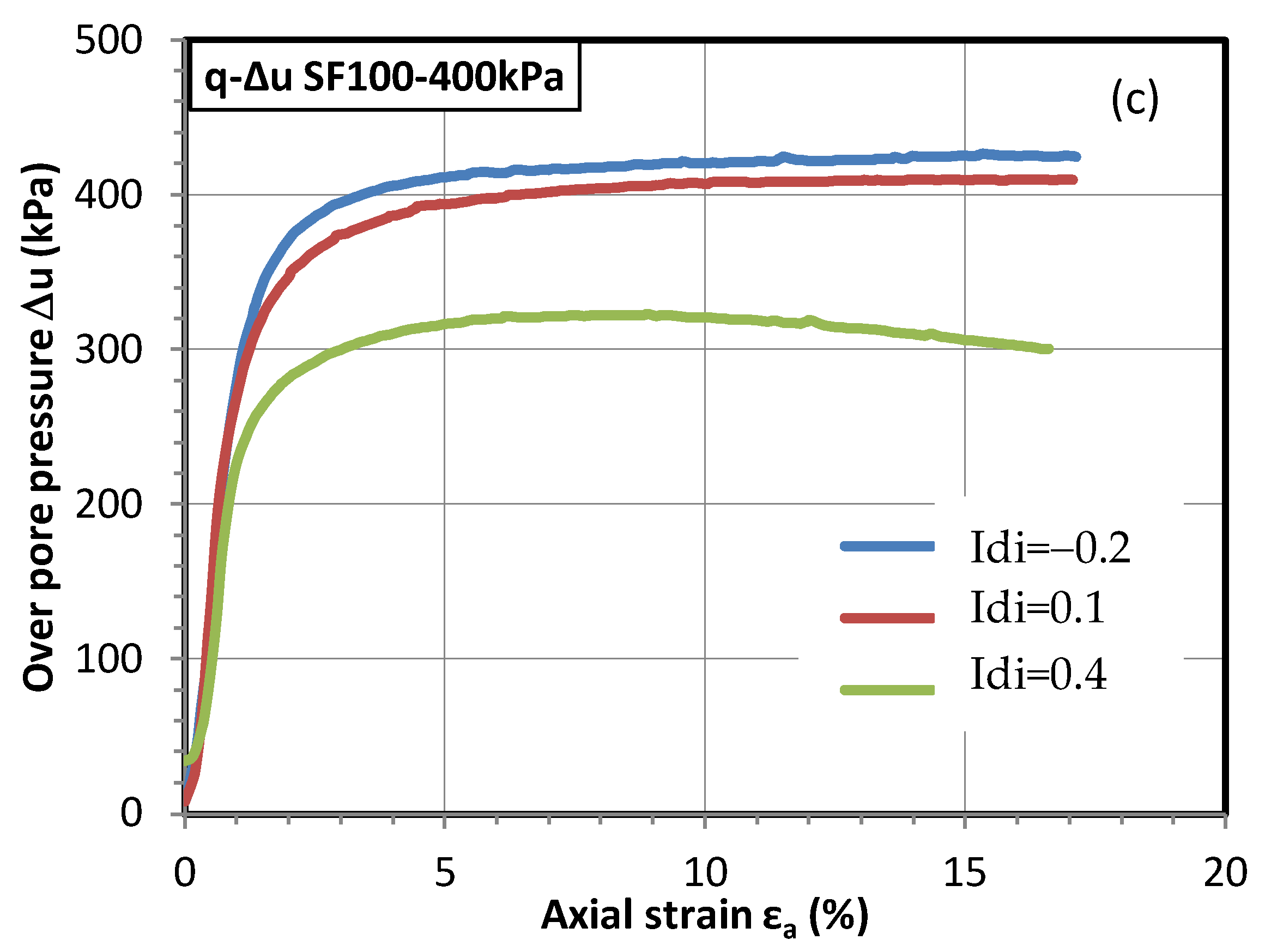



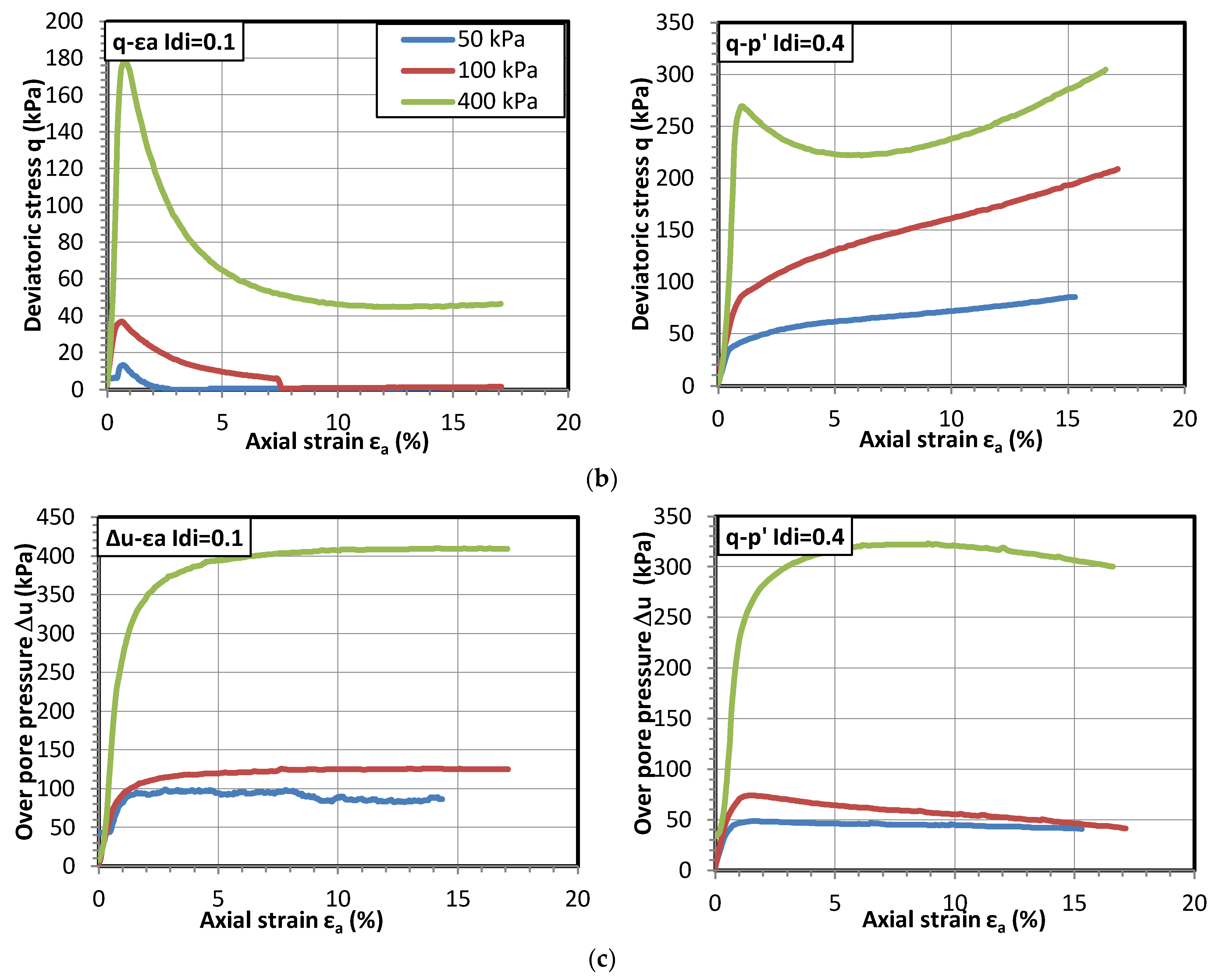




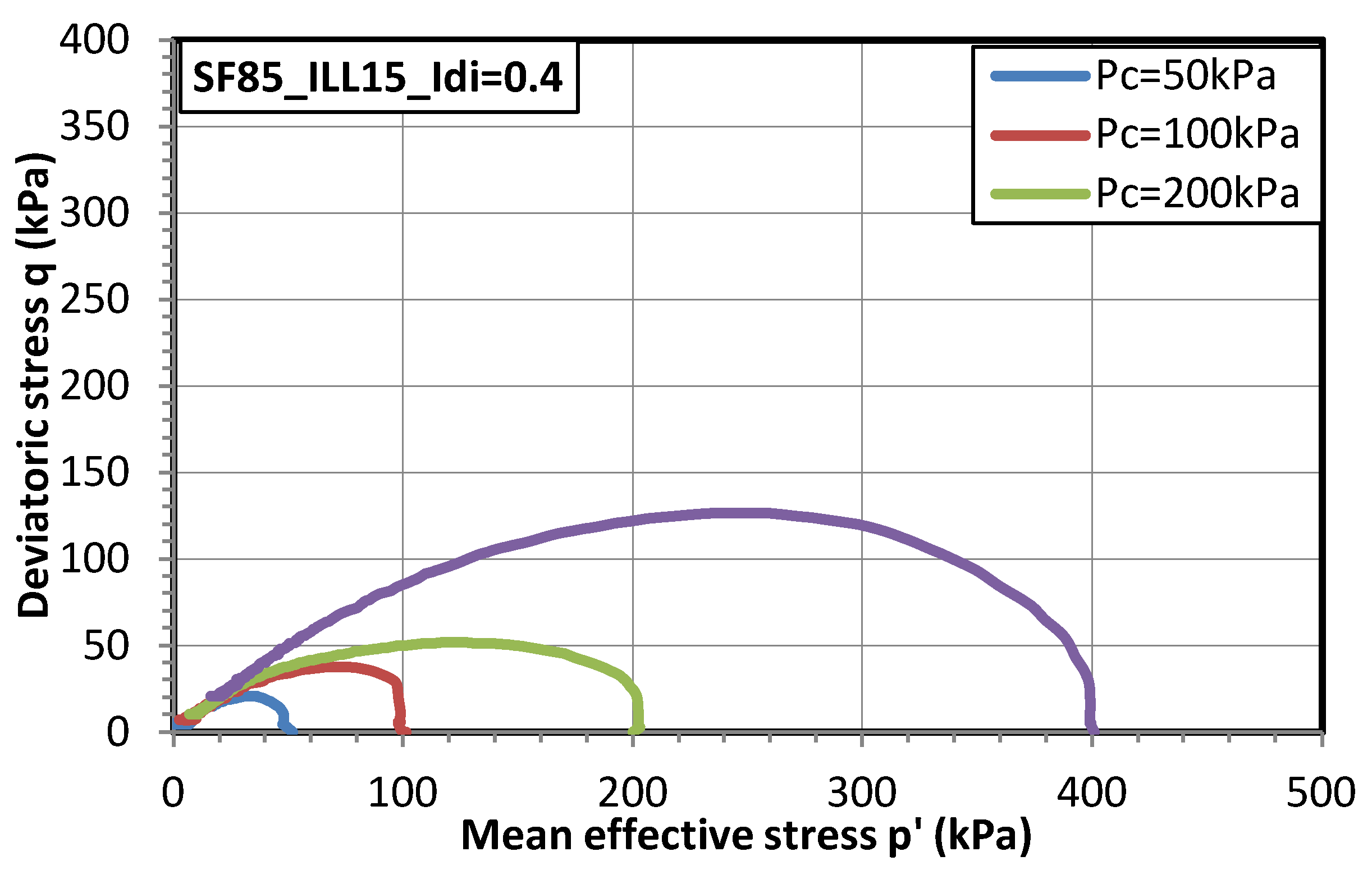

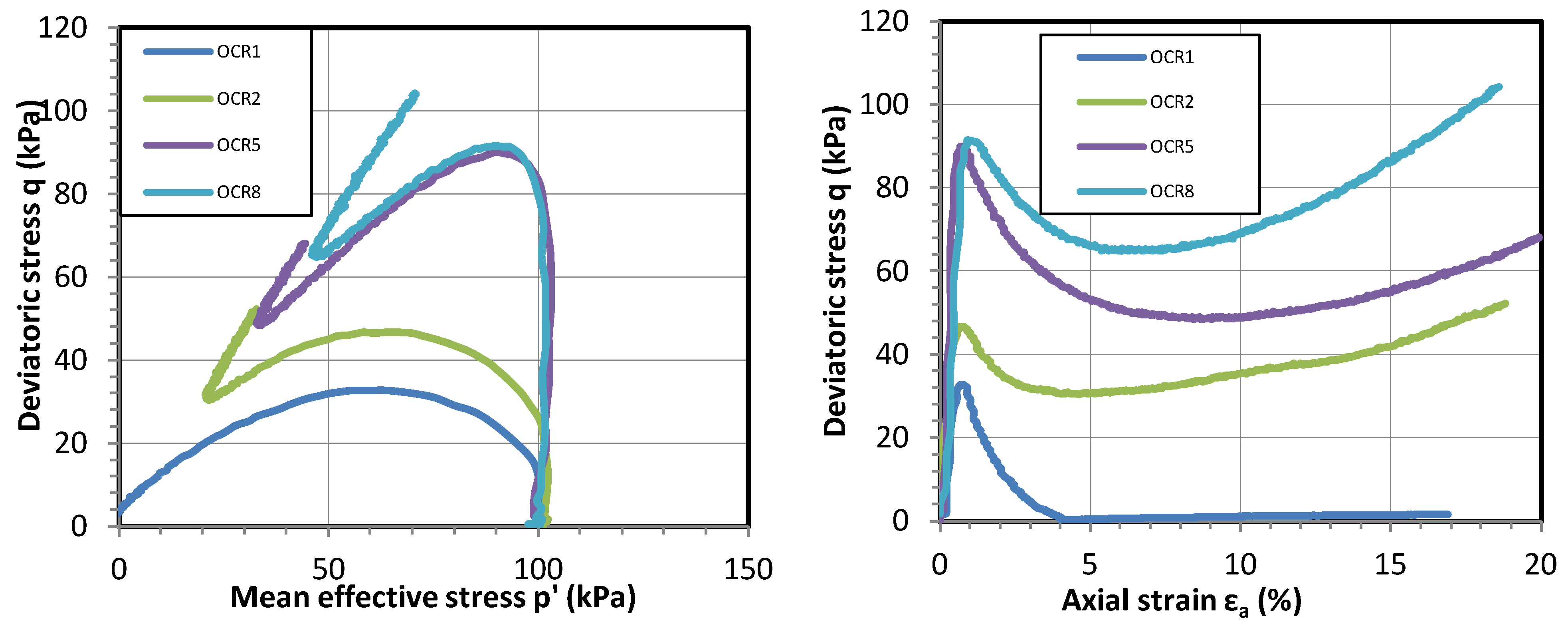
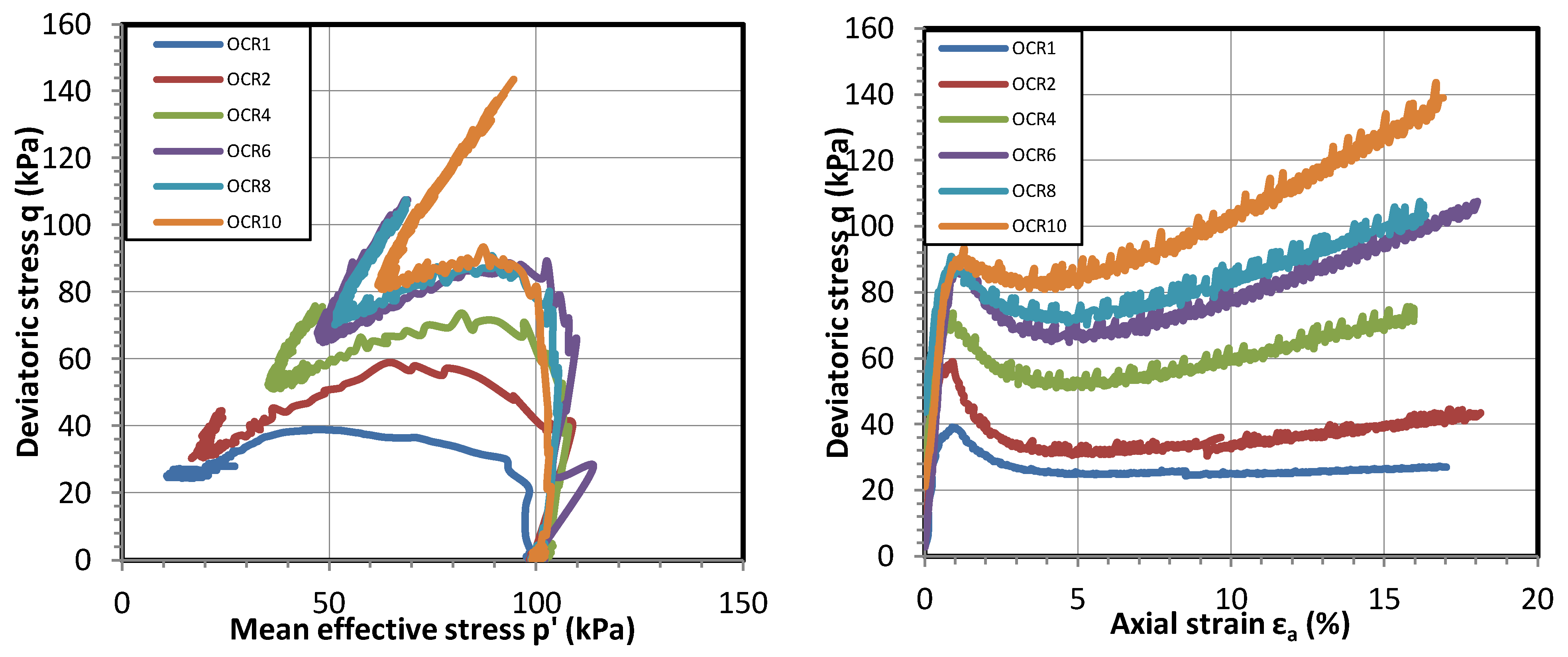

| dmax (mm) | dmin (mm) | d60 (mm) | d50 (mm) | d30 (mm) | d10 (mm) | Cc | Cu | ρ (g/cm3) |
|---|---|---|---|---|---|---|---|---|
| 0.4 | 0.08 | 0.232 | 0.211 | 0.165 | 0.119 | 0.99 | 1.96 | 2.65 |
| dmax (μm) | d50 (μm) | d60 (μm) | WL | Ip | ρ (g/cm3) |
|---|---|---|---|---|---|
| 44 | 2.2 | 5 | 51 | 29.3 | 2.65 |
| %SF | %ILL | wL | IP | wP |
|---|---|---|---|---|
| 100 | 0 | 29.83 | ||
| 97.5 | 2.5 | 25.55 | 23.27 | 2.29 |
| 95.00 | 5 | 22.38 | 20.53 | 1.85 |
| 92.50 | 7.5 | 21.13 | 19.79 | 1.34 |
| 90.00 | 10 | 19.18 | 17.06 | 2.12 |
| 85.00 | 15 | 19.08 | 13.32 | 5.76 |
| 80.00 | 20 | 17.18 | 8.10 | 9.08 |
| 75.00 | 25 | 19.34 | 8.23 | 11.11 |
| 0.00 | 100 | 51 | 21.29 | 29.71 |
| N°Test | %SF | %ILL | Pc (kPa) | Idi | OCR |
|---|---|---|---|---|---|
| Clean sand behavior | |||||
| 1 | 100 | 0 | 50 | −0.2 | 1 |
| 2 | 100 | 0 | 50 | 0.1 | 1 |
| 3 | 100 | 0 | 50 | 0.4 | 1 |
| 4 | 100 | 0 | 100 | −0.2 | 1 |
| 5 | 100 | 0 | 100 | 0.1 | 1 |
| 6 | 100 | 0 | 100 | 0.4 | 1 |
| 7 | 100 | 0 | 400 | −0.2 | 1 |
| 8 | 100 | 0 | 400 | 0.1 | 1 |
| 9 | 100 | 0 | 400 | 0.4 | 1 |
| Effect of fine content | |||||
| 10 | 100 | 0 | 100 | 0.0 | 1 |
| 11 | 95 | 5 | 100 | 0.0 | 1 |
| 12 | 90 | 10 | 100 | 0.0 | 1 |
| 13 | 85 | 15 | 100 | 0.0 | 1 |
| 14 | 85 | 15 | 100 | 0.2 | 1 |
| 15 | 80 | 20 | 100 | 0.2 | 1 |
| 16 | 75 | 15 | 100 | 0.2 | 1 |
| Effect of initial density index | |||||
| 13 | 85 | 15 | 100 | 0.0 | 1 |
| 14 | 85 | 15 | 100 | 0.2 | 1 |
| 19 | 85 | 15 | 100 | 0.4 | 1 |
| 20 | 85 | 15 | 100 | 0.6 | 1 |
| Effect of confining pressure | |||||
| 21 | 85 | 15 | 50 | 0.4 | 1 |
| 19 | 85 | 15 | 100 | 0.4 | 1 |
| 22 | 85 | 15 | 200 | 0.4 | 1 |
| 23 | 85 | 15 | 400 | 0.4 | 1 |
| Effect of OCR | |||||
| 24 | 100 | 0 | 100 | 0.2 | 1 |
| 25 | 100 | 0 | 100 | 0.2 | 2 |
| 26 | 100 | 0 | 100 | 0.2 | 5 |
| 27 | 100 | 0 | 100 | 0.2 | 8 |
| 28 | 85 | 15 | 100 | 0.2 | 1 |
| 29 | 85 | 15 | 100 | 0.2 | 2 |
| 30 | 85 | 15 | 100 | 0.2 | 4 |
| 31 | 85 | 15 | 100 | 0.2 | 6 |
| 32 | 85 | 15 | 100 | 0.2 | 8 |
| 33 | 85 | 15 | 100 | 0.2 | 10 |
Disclaimer/Publisher’s Note: The statements, opinions and data contained in all publications are solely those of the individual author(s) and contributor(s) and not of MDPI and/or the editor(s). MDPI and/or the editor(s) disclaim responsibility for any injury to people or property resulting from any ideas, methods, instructions or products referred to in the content. |
© 2024 by the authors. Licensee MDPI, Basel, Switzerland. This article is an open access article distributed under the terms and conditions of the Creative Commons Attribution (CC BY) license (https://creativecommons.org/licenses/by/4.0/).
Share and Cite
Dang, Q.-H.; Reiffsteck, P.; Vu, M.-N.; Nguyen-Sy, T.; Pham, V.-H. Effect of Plastic Fine Content on the Static Liquefaction Potential of Sandy Soil. Appl. Sci. 2024, 14, 5881. https://doi.org/10.3390/app14135881
Dang Q-H, Reiffsteck P, Vu M-N, Nguyen-Sy T, Pham V-H. Effect of Plastic Fine Content on the Static Liquefaction Potential of Sandy Soil. Applied Sciences. 2024; 14(13):5881. https://doi.org/10.3390/app14135881
Chicago/Turabian StyleDang, Quang-Huy, Philippe Reiffsteck, Minh-Ngoc Vu, Tuan Nguyen-Sy, and Van-Hung Pham. 2024. "Effect of Plastic Fine Content on the Static Liquefaction Potential of Sandy Soil" Applied Sciences 14, no. 13: 5881. https://doi.org/10.3390/app14135881







